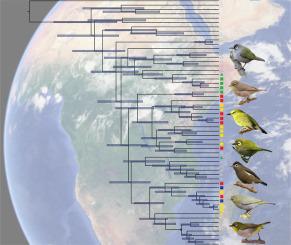当前位置:
X-MOL 学术
›
Mol. Phylogenet. Evol.
›
论文详情
Our official English website, www.x-mol.net, welcomes your
feedback! (Note: you will need to create a separate account there.)
A comprehensive molecular phylogeny of Afrotropical white-eyes (Aves: Zosteropidae) highlights prior underestimation of mainland diversity and complex colonisation history.
Molecular Phylogenetics and Evolution ( IF 3.6 ) Pub Date : 2020-04-21 , DOI: 10.1016/j.ympev.2020.106843 Frederico C Martins 1 , Siobhan C Cox 2 , Martin Irestedt 3 , Robert P Prŷs-Jones 4 , Julia J Day 1
Molecular Phylogenetics and Evolution ( IF 3.6 ) Pub Date : 2020-04-21 , DOI: 10.1016/j.ympev.2020.106843 Frederico C Martins 1 , Siobhan C Cox 2 , Martin Irestedt 3 , Robert P Prŷs-Jones 4 , Julia J Day 1
Affiliation

|
White-eyes (Zosterops) are a hyper-diverse genus of passerine birds that have rapidly radiated across the Afrotropics and Southeast Asia. Despite their broad range, a disproportionately large number of species are currently recognised from islands compared to the mainland. Described species-level diversity of this 'great speciator' from continental Africa-Arabia is strikingly low, despite the vast size and environmental complexity of this region. However, efforts to identify natural groups using traditional approaches have been hindered by the remarkably uniform morphology and plumage of these birds. Here, we investigated the phylogenetic relationships and systematics of Afrotropical Zosterops, including the Gulf of Guinea and western Indian Ocean islands. We included exceptional sampling (~160 individuals) from all except one subspecies of the 55 taxa (32 species, plus 23 additional named sub-species) currently recognized throughout the region, in addition to a subset of extra-Afrotropical taxa, by exploiting blood and archival samples. Employing a multi-locus phylogenetic approach and applying quantitative species delimitation we tested: (1) if there has been a single colonisation event of the Afrotropical realm; (2) if constituent mainland and island birds are monophyletic; and (3) if mainland diversity has been underestimated. Our comprehensive regional phylogeny revealed a single recent colonisation of the Afrotropical realm c.1.30 Ma from Asia, but a subsequent complex colonisation history between constituent island and mainland lineages during their radiation across this vast area. Our findings suggest a significant previous underestimation of continental species diversity and, based on this, we propose a revised taxonomy. Our study highlights the need to densely sample species diversity across ranges, providing key findings for future conservation assessments and establishing a robust framework for evolutionary studies.
中文翻译:

亚非性白眼(Aves:Zosteropidae)的全面分子系统发育研究突显了先前对大陆多样性和复杂殖民历史的低估。
白眼(Zosterops)是一种雀形目鸟类的超多样性属,已迅速在非洲和东南亚地区辐射开来。尽管范围广泛,但与大陆相比,目前从岛屿上发现的物种数量不成比例。尽管该地区的面积巨大且环境复杂,但从非洲大陆到阿拉伯大陆的这种“伟大的物种”所描述的物种水平的多样性却非常低。但是,由于这些鸟类的形态和羽毛非常均匀,阻碍了使用传统方法鉴定自然种群的努力。在这里,我们调查了包括几内亚湾和西印度洋诸岛在内的非热带带翅类动物的系统发育关系和系统。通过利用血液,我们从整个地区目前公认的55个分类群(32个物种,外加23个其他命名的亚种)中,除了一个亚种之外,还从所有亚种中抽取了约160名个体,此外还有一部分非嗜血类群。和档案样本。我们采用多基因组系统发育方法并采用定量物种定界方法进行了测试:(1)是否存在非嗜境性领域的单个定殖事件;(2)大陆鸟和海岛鸟是否具有单性;(3)大陆的多样性是否被低估了?我们全面的区域系统发育史表明,亚洲的非热带境界c.1.30 Ma近期有一次定殖,但随后在组成的岛屿和大陆沿整个广阔区域辐射期间,它们之间又发生了复杂的定殖历史。我们的发现表明,以前对大陆物种多样性的估计过低,因此,我们提出了修订的分类法。我们的研究强调需要在各个范围内密集采样物种多样性,为将来的保护评估提供关键发现,并为进化研究建立一个可靠的框架。
更新日期:2020-04-21
中文翻译:

亚非性白眼(Aves:Zosteropidae)的全面分子系统发育研究突显了先前对大陆多样性和复杂殖民历史的低估。
白眼(Zosterops)是一种雀形目鸟类的超多样性属,已迅速在非洲和东南亚地区辐射开来。尽管范围广泛,但与大陆相比,目前从岛屿上发现的物种数量不成比例。尽管该地区的面积巨大且环境复杂,但从非洲大陆到阿拉伯大陆的这种“伟大的物种”所描述的物种水平的多样性却非常低。但是,由于这些鸟类的形态和羽毛非常均匀,阻碍了使用传统方法鉴定自然种群的努力。在这里,我们调查了包括几内亚湾和西印度洋诸岛在内的非热带带翅类动物的系统发育关系和系统。通过利用血液,我们从整个地区目前公认的55个分类群(32个物种,外加23个其他命名的亚种)中,除了一个亚种之外,还从所有亚种中抽取了约160名个体,此外还有一部分非嗜血类群。和档案样本。我们采用多基因组系统发育方法并采用定量物种定界方法进行了测试:(1)是否存在非嗜境性领域的单个定殖事件;(2)大陆鸟和海岛鸟是否具有单性;(3)大陆的多样性是否被低估了?我们全面的区域系统发育史表明,亚洲的非热带境界c.1.30 Ma近期有一次定殖,但随后在组成的岛屿和大陆沿整个广阔区域辐射期间,它们之间又发生了复杂的定殖历史。我们的发现表明,以前对大陆物种多样性的估计过低,因此,我们提出了修订的分类法。我们的研究强调需要在各个范围内密集采样物种多样性,为将来的保护评估提供关键发现,并为进化研究建立一个可靠的框架。











































 京公网安备 11010802027423号
京公网安备 11010802027423号